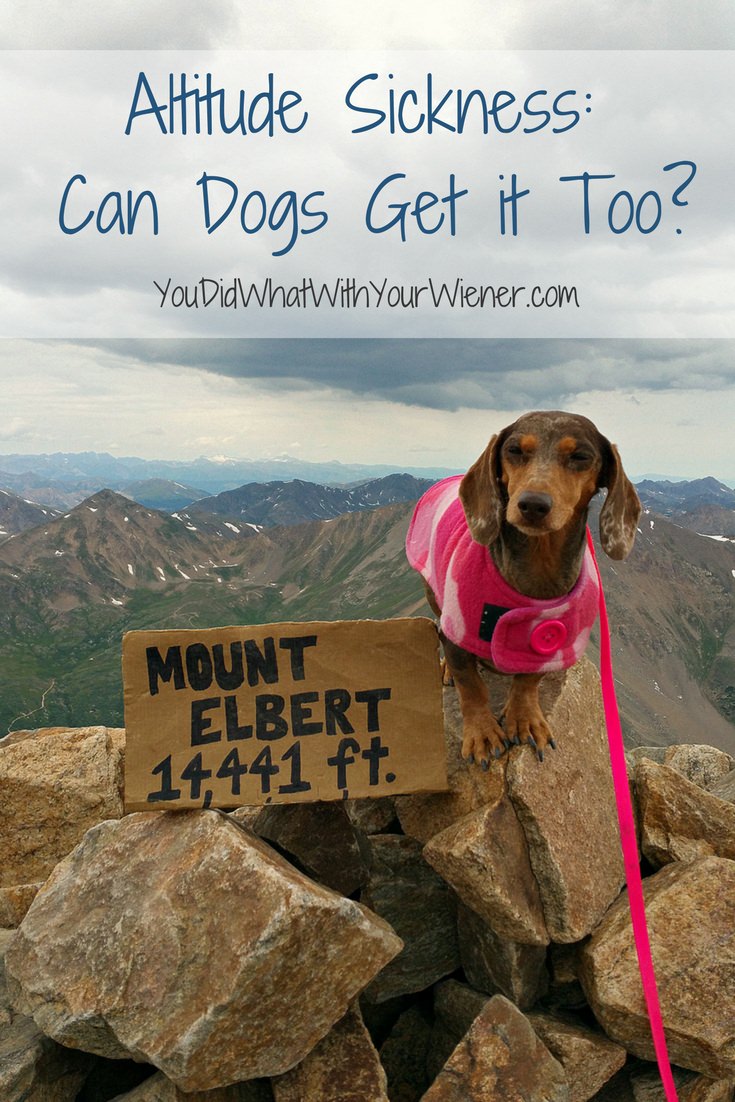Can Dogs Get Altitude Sickness?
Whether you are moving to Colorado or hiking a to mountain peak over 10,000 feet, you may be wondering if your dog can get altitude sickness.
I became curious about this a few years ago when I was planning a road trip to Colorado with my small dogs.
Article originally publishes August 2015
We planned to stay in Denver, Leadville, and several other high elevation towns.
We also planned to hike Mount Elbert – the highest peak in Colorado and the highest peak in the “lower 48” (US) that dogs are allowed on.
Denver, often referred to as the mile-high city, is 5,280 feet above sea level. Leadville sits at 10,000 feet and Mount Elbert tops out at 14,439 feet.
All three of these destinations area above the elevation threshold where altitude sickness can occur.
I thought we were at especially high risk because the City we live in is barely over 500 feet above sea level.
My pre-trip research revealed that, yes, dogs can indeed bet altitude sickness but it’s not common.
What is Altitude Sickness?
Altitude sickness is something that happens to dogs and people when they move to a higher elevation too quickly.
Air at higher elevations contains less oxygen (has a lower oxygen pressure). A body can experience physical distress while it’s trying to adjust to this.
This distress can manifest in several ways and can be classified into three main types by symptoms.
Altitude sickness is created by the lack of oxygen at high elevations
Acute Mountain Sickness
The milder of the three is called Acute Mountain Sickness (AMS) or simply “mountain sickness”.
It’s the most common and what people typically think of when referring to altitude sickness.
In most cases, although it makes a dog or person feel horrible, Acute Mountain Sickness it can be treated at home or “in the field”.
The other two types, which are much more serious.
High Altitude Pulmonary Edema
High Altitude Pulmonary Edema, or HAPE, characterized by fluid buildup in the lungs.
It’s a form of noncardiogenic pulmonary edema (basically, not caused by heart issues).
It is a life threatening condition that requires medical attention.
High Altitude Cerebral Edema
High Altitude Cerebral Edema, or HACE, is characterized by fluid buildup in the brain.
The first one makes a dog or person feel horrible but it can be treated “at home” in most cases.
This condition is also life threatening and medical attention is imperative.
When Can a Dog Get Altitude Sickness?
People sometimes get altitude sickness when they reach an elevation of 8,000 feet or higher.
It’s expected it is the same for dogs (they can’t tell us for sure).
Just as not every person develops altitude sickness, neither does every dog. In fact, dogs are less susceptible to it than humans.
Some dogs are more susceptible to altitude sickness than others
Dogs that are more susceptible to altitude sickness include:
- Dogs with underlying medical conditions, especially ones affecting the lungs and the ability of their hear to pump oxygenated blood
- Brachycephalic dogs such as boxers, bulldogs and pugs
- Senior Dogs
Are Small Dogs More Susceptible to Altitude Sickness?
I wondered if the likelihood of altitude sickness could increase the smaller the dog is.
My thinking was that a smaller body might have a harder time adjusting or breathing in enough oxygen.
Honestly, I couldn’t find any information about altitude sickness specifically as it applies to small dogs or a reduced body mass.
However, I suspect the answer would be related to the difference between adult humans and children so I researched that.
This study found that, “… children are no more likely to develop acute mountain sickness than adults.”
I also did a little digging into altitude sickness for smaller mammals like rats.
Nothing I found indicated that smaller animals are more susceptible to altitude sickness than larger ones.
Therefore, it appears that both large and small dogs can develop altitude sickness, or not, at the same rate.
Symptoms of Altitude Sickness in Dogs
Unfortunately, dogs can’t tell us when they feel sick and will often push themselves to please us.
It’s important to know the signs and symptoms of altitude sickness so you can recognize when your pup may be in trouble.
The symptoms can vary but include:
- Hyperventilation/excessive panting
- Excessive drooling
- Dry Cough
- Vomiting
- Pale gums
- Increased pulse
- Swelling of feet and possibly the face
- Dizziness and lack of coordination
- Lethargy and refusal to move
- Headache (not usually a visible sign in dogs but their head can hurt)
- Bleeding from the nose and retina (only in extreme cases)
A dog experiencing altitude sickness will usually exhibit several of these symptoms at once
Preparing a Dog for High Altitude
To prepare the body for higher elevation and thinner air with less oxygen, it’s best if you can stay for several days to weeks at higher elevation to help your dog’s body adjust.
Choose an elevation that is higher than normal for your dog but below the 8,000 feet threshold.
I know is not always realistic if you are going on a quick or last-minute trip trip though.
Other things you can do to help prevent altitude sickness in your dog are:
- Increase your dog’s fitness, and ability for their body to update oxygen, by starting with lower elevation hikes and gradually increasing to harder, higher trails.
- Hike at a slower pace to make the ascent more gradual
- Make sure that your dog is drinking enough water
- Add flavored electrolytes for dogs to their water to entice them to drink and maintain optimal athletic performance
Prevention is the best medicine but it’s not a guarantee that your dog won’t get altitude sickness
What to Do if Your Dog Shows Signs of Altitude Sickness
If your dog is showing signs of altitude sickness, you should:
- Immediately descend to a lower elevation, ideally below 8,000 feet
- Give them plenty of water to rehydrate (you might have to pour it down their throat using a syringe from your first aid kit)
- Rest until their behavior and respiration/heartbeat returns to normal
Most dogs recover well after treatment and returning to their normal altitude.
If something still seems off after you do the above, get them to a veterinarian as soon as possible.
They may have one of the more acute types of altitude sickness (HAPE or HACE) or there may be something else going on.
Our Experience Hiking the Highest Mountain in Colorado with Dogs
We had been in Colorado for a couple of days, but at a lower elevation than Leadville (10,000 feet), when we attempted to hike Mt. Sherman (14,035 feet at the top).
Right away, Chester was hiking slow. We chalked it up to his old age – he was around 12 at the time – and put him in my backpack.
Gretel wanted to charge to the top as usual so we let her hike.
The person that definitely got altitude sickness was me. I got a headache, became weaker, and felt nautious.
I recognized the signs so we stopped immediately and decided try a 14er again after recovering and acclimating for a few days.
We took it easy around town the next couple of days.
Everyone told me that drinking lots and lots of water – “so much that you are drowning” to be exact – would help so I made sure to hydrate as much as I could.
I tried taking my severe headache medicine but it wasn’t helping.
So I did what you do and took to Mr. Google to see if something else would help.
It turns out that plain ol’ ibuprofen can help with altitude sickness.
We used the down-time to see more of Colorado, including the Maroon Bells, Aspen, and Top of the Rockies National Scenic Byway.
The increase in altitude sickness wasn’t an issue for my small dogs but I sure felt it
After resting for a few days, and driving to Leadville, CO at 10,000 feet above sea level to further acclimate, we were all feeling pretty good.
On our last day in Leadville before heading home, we attempted the Mt. Elbert hike.
My Dachshunds Chester and Gretel appeared unphased by the hike. So did my hubby. However, I started feeling sick again near the top.
I insisted that he go ahead to the top with the dogs since they were clearly capable of making it.
After taking about 15 minutes to hike the last couple hundred feet, and swearing I was going to stop every labored step, I arrived at the Summit!


About the Author
Hi, I’m Jessica. I’ve been studying the Dachshund breed since 2007, owned 3 of my own, and shared in the lives of thousands of others through their owner’s stories. When I’m not sharing what I know on this blog, you can find me hiking, camping, and traveling with my adventurous wiener dogs.


It stands to reason that dogs could be effected, just like people. What a bummer though, I know you had high hopes to hike those peaks.
Oh, it wasn’t a bummer. Our main goal was to hike to the top of Mt. Elbert – which we were able to do at the very end. Mt. Sherman – the one we had to turn back on – was just an “easy” warm up. It turned out that Elbert was easier! But buy, it sure wasn’t easy. Toward the end, I swore I was quitting at least 50 times. The fact that I kept going and actually made it was a very joyous accomplishment.
Yes, I could have done without the altitude sickness though 🙂
I can get altitude sickness on a stepladder. That’s why I live my life at sea level, but I do enjoy pictures taken in the mountains.
That’s funny. My Dad has really bad motion sickness and he always says he can get sick watching a merry-go-round.
It’s perfectly ok to live vicariously through others 🙂
I am lucky that I don’t seem to get altitude sickness. A few years ago I was at a conference in Denver and half the people felt sick from the change. Glad it passed for you.
As a longtime Coloradoan, I can speak first hand about the altitude. Kudos for doing Leadville (probably my favorite city in the state). That said, doing any of the 14’ers is a challenge, even the so-called ‘easy’ ones. Jogging around our neighborhood in Denver (elev. 5280) can still kick my butt and yes, hydration is one of the best ways to cope. I think you were smart to slowly graduate to higher elevations. Hope you enjoyed our beautiful state. 🙂
It sounds like you all did a good job of staying alert to serious issues and taking care of yourselves.
Glad you were able to push through and accomplish your goal by the end. It may be that your body needed the extra time to get acclimated.
I remember traveling to a conference where I met a woman from Colorado. She said that alcohol affected her differently in New Orleans than it did when she was home in the mountains. But I can’t remember if it hit her harder or didn’t do a thing.
Did you find anything similar?
I know something about altitude sickness as I’ve been to Tibet, and that is high! I remember the first time in Denver having the headache though. A lot of people on our trip to Tibet/China got a prescription from their doctors for altitude sickness beforehand. The water is the trick I think, those that drank beer the two days on the train regretted it when we got there. I remember being out of breath walking fast with luggage. We even had oxygen in our hotel rooms. Its sad about how it affects the dogs as they can’t tell you how they are feeling. But I think Gretel did have a headache. Glad you listened to your bodies and took it easy, and most of all that you completed the hike.
Glad you are doing well now. When I hiked Mt. Whitney in 2001, so long ago, I was doing great and did not succumb until I had hit the summit. It was not fun getting altitude sickness, I actually felt as if I was having a heart attack. My companions had to take me to the hospital, it was bad but I was in for a week long recovery. So glad you didn’t experience anything that bad.
I had no clue! This is good to know, for our future trips. We have four very active dogs and are looking to do a lot more camping and hiking. I’ve never paid much attention to altitude so this will have to be something to keep in mind for some of our next trips.
Our most recent road trip in Pisgah and Nantahala National Forest we did hit an elevation of 6k almost 7k at one point, so we got close to that threshold.
Great topic and hope it gets distributed to dog owners in Colorado! Thought I would share that at least one vet says Gatorade is fine for pets: http://www.petplace.com/article/dogs/dr-debras-faqs-and-posts/ask-dr-debra-common-questions/can-i-give-my-dog-gatorade
Great, thanks for the link Larry!
Great article! Thought you might like to know that at least one vet says Gatorade is fine for dogs: http://www.petplace.com/article/dogs/dr-debras-faqs-and-posts/ask-dr-debra-common-questions/can-i-give-my-dog-Gatorade
I never though about altitude sickness effecting dogs too! I’ve skied a lot throughout my life so it’s always been something to consider. Great detailed info, thanks!
I’m nerdy like that so I think about those things when we hike. Ha, ha. Thanks for stopping by the blog to say hi.